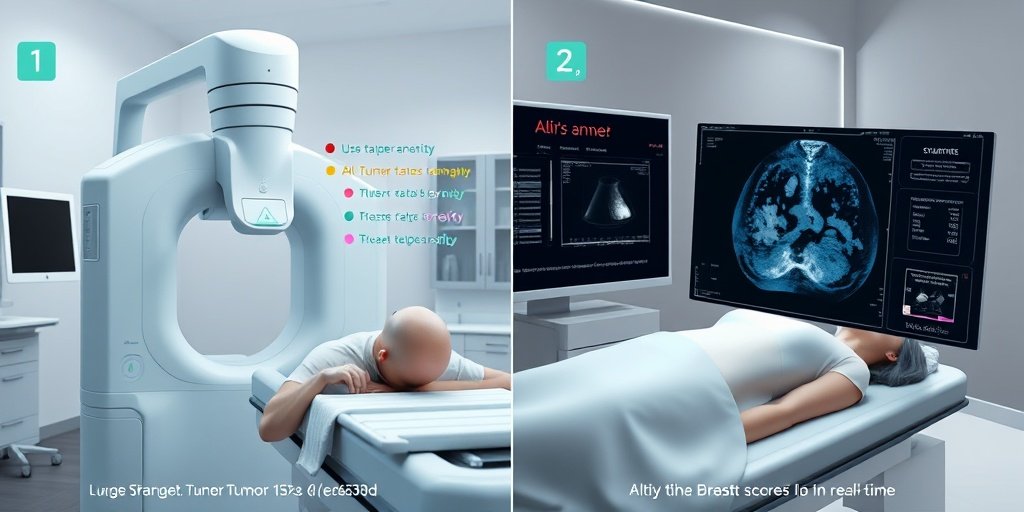⚡ Quick Summary
This study evaluated the agreement between AI-based tumor size measurements and final pathology results in breast cancer patients, involving 925 women and 936 breast cancers. The findings indicate that AI measurements with a 50% abnormality score showed moderate agreement with histopathology, highlighting the need for further refinement in AI technologies.
🔍 Key Details
- 📊 Dataset: 925 women, 936 breast cancers
- 🧩 Imaging modalities: Digital mammography, breast ultrasound, magnetic resonance imaging
- ⚙️ Technology: AI-based tumor size measurement
- 🏆 Performance: ICC for AI at 50% abnormality score: 0.54
🔑 Key Takeaways
- 📊 AI-based measurements showed moderate agreement with histopathology.
- 💡 The highest agreement was observed at an abnormality score of 50% (ICC = 0.54).
- 👩🔬 Ductal carcinoma in situ and HER2-positive cancers had higher agreement with AI (ICC = 0.76 and ICC = 0.73).
- 🤖 Over half of the cases (52.0%) were discordant between AI and pathology results.
- 🏥 Discordance was more common in younger patients with dense breasts.
- 🌍 The study emphasizes the need for further research and refinement of AI technologies.

📚 Background
Breast cancer remains a significant health concern worldwide, necessitating accurate diagnostic tools for effective treatment planning. Traditional imaging methods, while valuable, can sometimes fall short in precision. The integration of artificial intelligence (AI) into tumor size measurement presents a promising avenue for enhancing diagnostic accuracy and improving patient outcomes.
🗒️ Study
This retrospective study included 925 women with a mean age of 55.3 years who underwent various imaging modalities before breast cancer surgery. The researchers aimed to assess the agreement between AI-based tumor size measurements and final pathology results, utilizing intraclass correlation coefficient (ICC) analysis to evaluate the data.
📈 Results
The study found that tumor size measurements with an abnormality score of 50% exhibited the highest agreement with histopathology, achieving an ICC of 0.54. Notably, for specific cancer types such as ductal carcinoma in situ and HER2-positive cancers, AI measurements demonstrated even higher agreement (ICC = 0.76 and ICC = 0.73, respectively). However, a significant 52.0% of cases were discordant, particularly among younger patients with dense breast tissue.
🌍 Impact and Implications
The findings of this study underscore the potential of AI in enhancing tumor size measurements in breast cancer diagnostics. While the moderate agreement with histopathology is promising, the high rate of discordance highlights the need for ongoing research and refinement of AI technologies. As AI continues to evolve, it could play a crucial role in improving diagnostic accuracy and ultimately patient care in oncology.
🔮 Conclusion
This study illustrates the potential of AI-based tumor size measurements in breast cancer diagnostics, revealing both strengths and limitations. While AI shows promise in achieving moderate agreement with histopathology, the significant discordance in cases calls for further investigation and technological advancements. The future of AI in healthcare looks promising, and continued research is essential to harness its full potential.
💬 Your comments
What are your thoughts on the integration of AI in breast cancer diagnostics? We would love to hear your insights! 💬 Leave your comments below or connect with us on social media:
Artificial intelligence-based tumor size measurement on mammography: agreement with pathology and comparison with human readers’ assessments across multiple imaging modalities.
Abstract
PURPOSE: To evaluate the agreement between artificial intelligence (AI)-based tumor size measurements of breast cancer and the final pathology and compare these results with those of other imaging modalities.
MATERIAL AND METHODS: This retrospective study included 925 women (mean age, 55.3 years ± 11.6) with 936 breast cancers, who underwent digital mammography, breast ultrasound, and magnetic resonance imaging before breast cancer surgery. AI-based tumor size measurement was performed on post-processed mammographic images, outlining areas with AI abnormality scores of 10, 50, and 90%. Absolute agreement between AI-based tumor sizes, image modalities, and histopathology was assessed using intraclass correlation coefficient (ICC) analysis. Concordant and discordant cases between AI measurements and histopathologic examinations were compared.
RESULTS: Tumor size with an abnormality score of 50% showed the highest agreement with histopathologic examination (ICC = 0.54, 95% confidential interval [CI]: 0.49-0.59), showing comparable agreement with mammography (ICC = 0.54, 95% CI: 0.48-0.60, p = 0.40). For ductal carcinoma in situ and human epidermal growth factor receptor 2-positive cancers, AI revealed a higher agreement than that of mammography (ICC = 0.76, 95% CI: 0.67-0.84 and ICC = 0.73, 95% CI: 0.52-0.85). Overall, 52.0% (487/936) of cases were discordant, with these cases more commonly observed in younger patients with dense breasts, multifocal malignancies, lower abnormality scores, and different imaging characteristics.
CONCLUSION: AI-based tumor size measurements with abnormality scores of 50% showed moderate agreement with histopathology but demonstrated size discordance in more than half of the cases. While comparable to mammography, its limitations emphasize the need for further refinement and research.
Author: [‘Kwon MR’, ‘Kim SH’, ‘Park GE’, ‘Mun HS’, ‘Kang BJ’, ‘Kim YT’, ‘Yoon I’]
Journal: Radiol Med
Citation: Kwon MR, et al. Artificial intelligence-based tumor size measurement on mammography: agreement with pathology and comparison with human readers’ assessments across multiple imaging modalities. Artificial intelligence-based tumor size measurement on mammography: agreement with pathology and comparison with human readers’ assessments across multiple imaging modalities. 2025; (unknown volume):(unknown pages). doi: 10.1007/s11547-025-02033-8